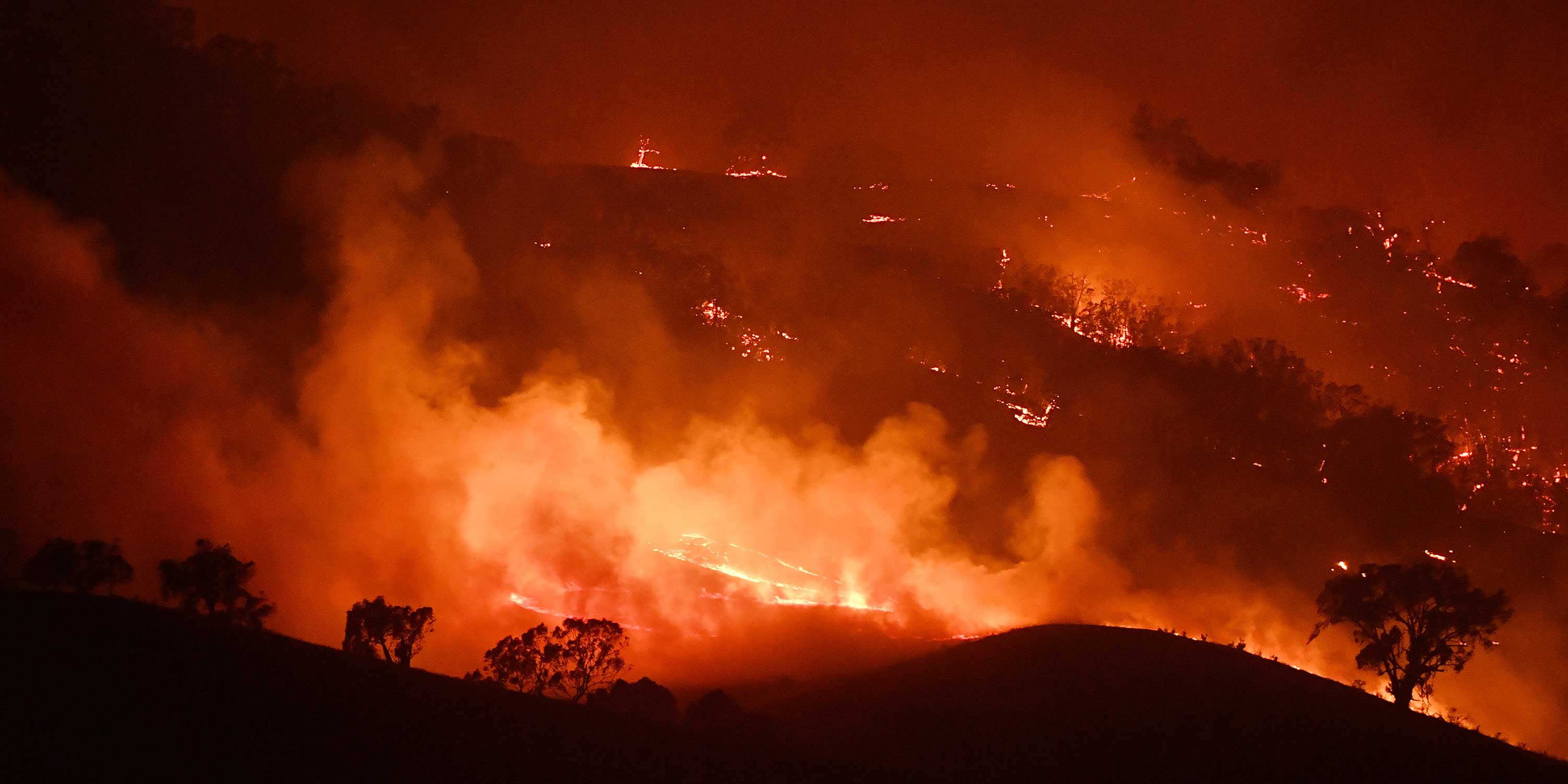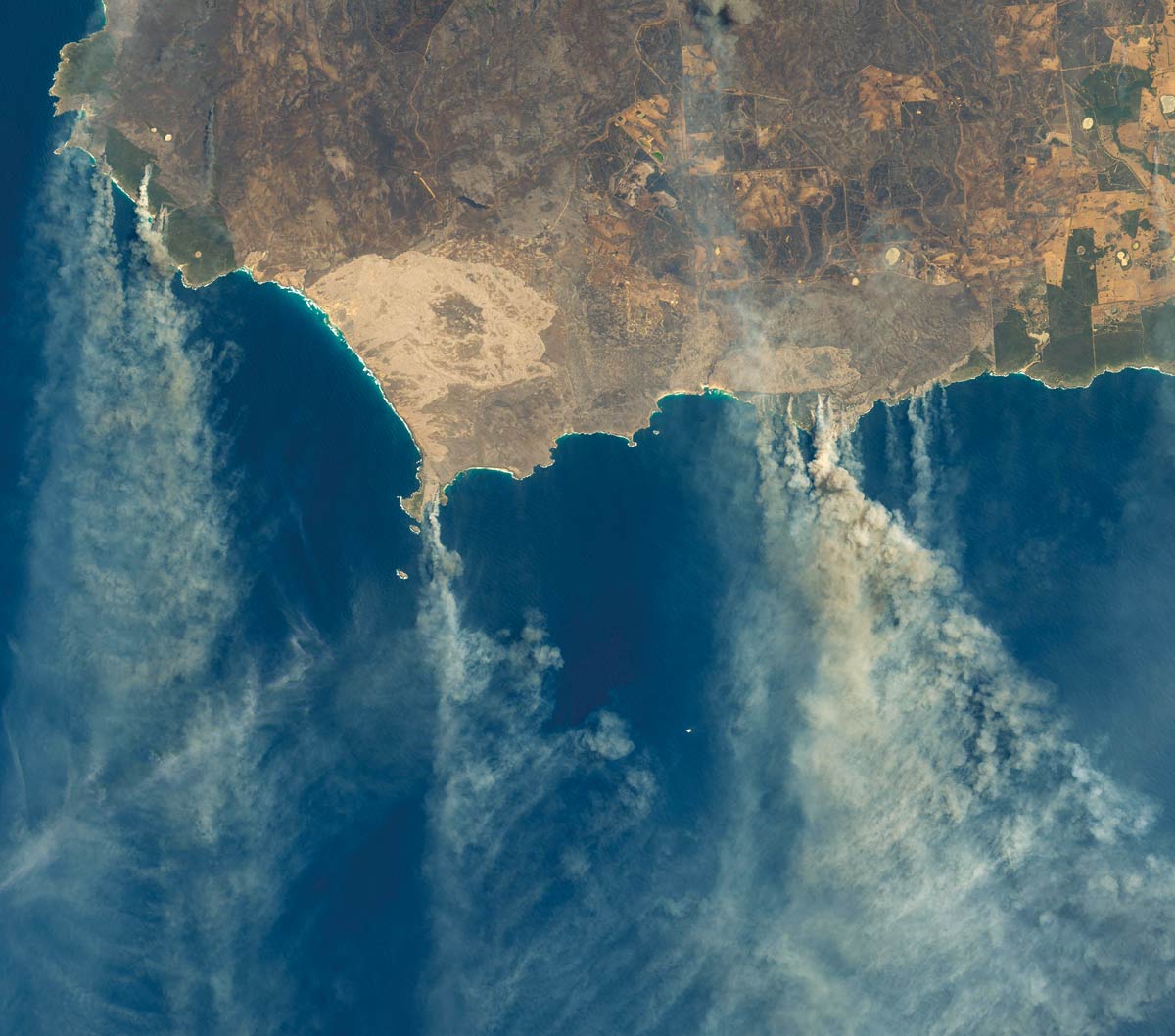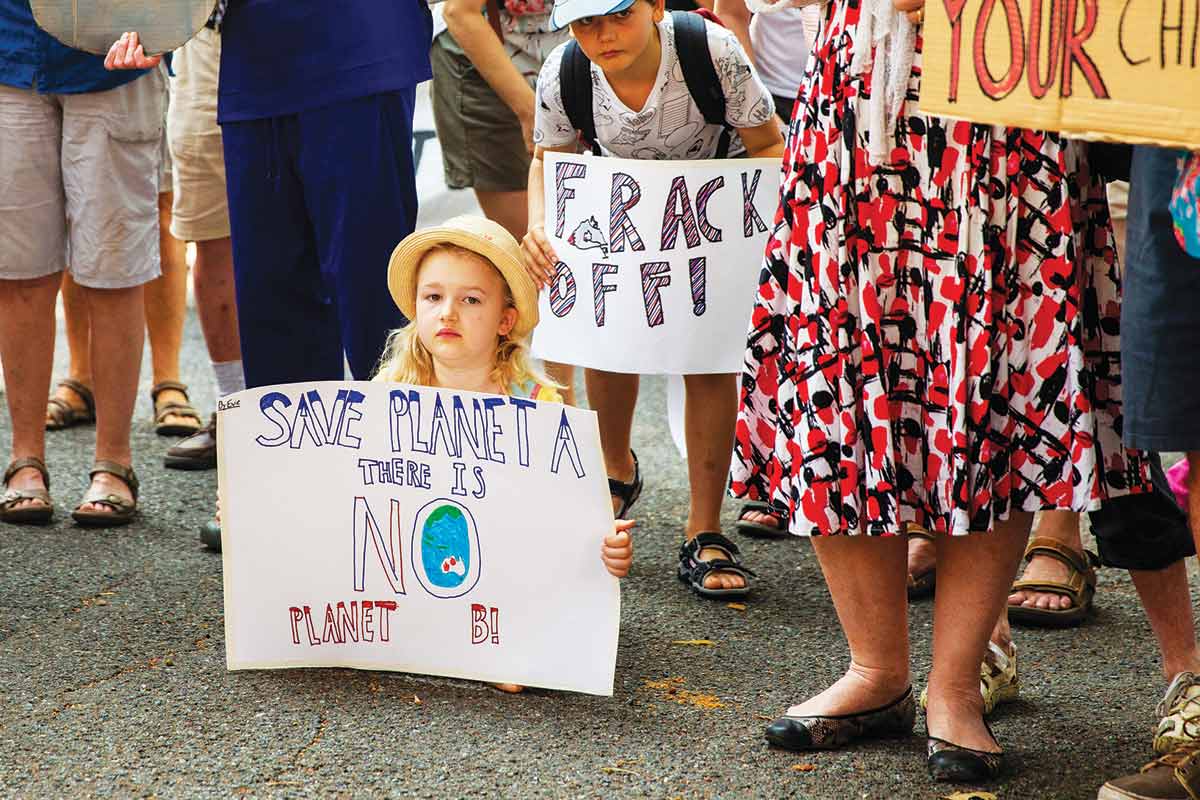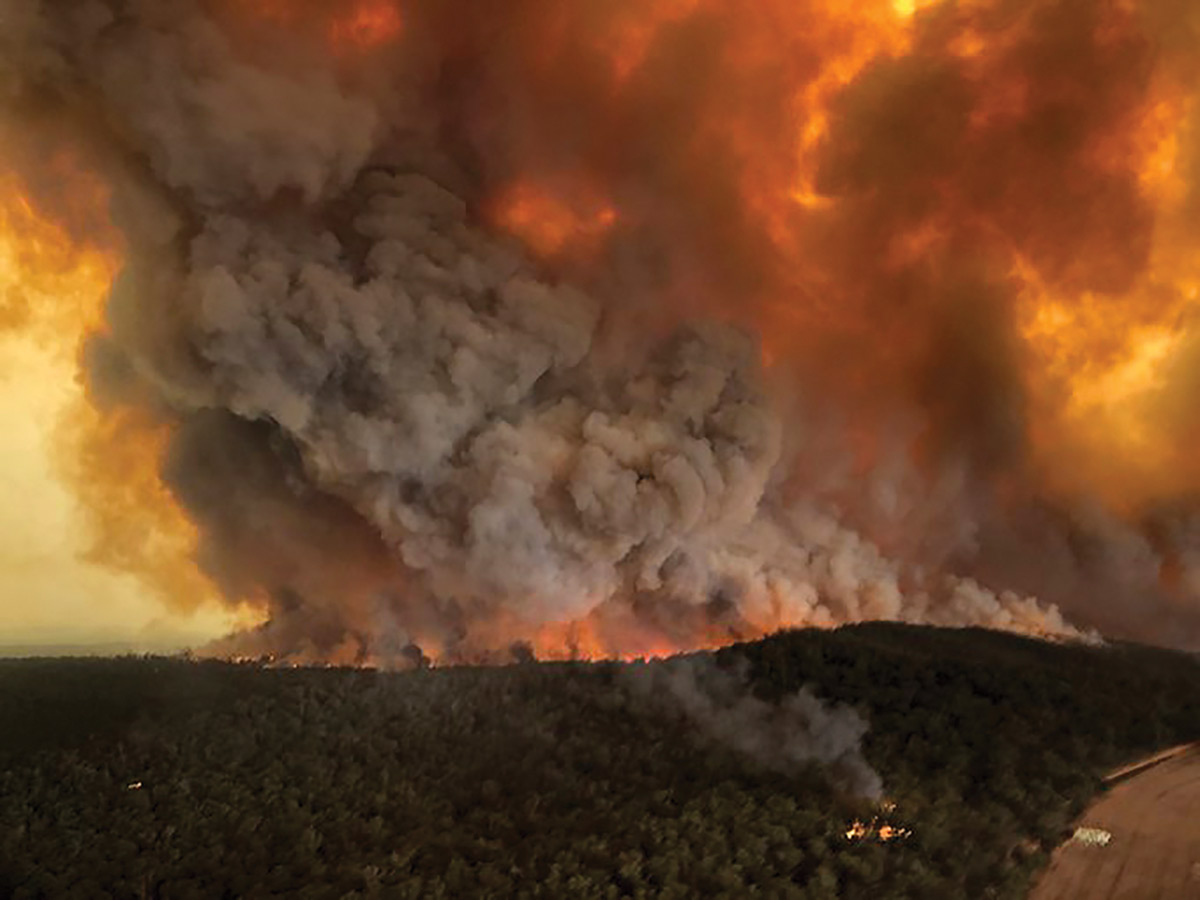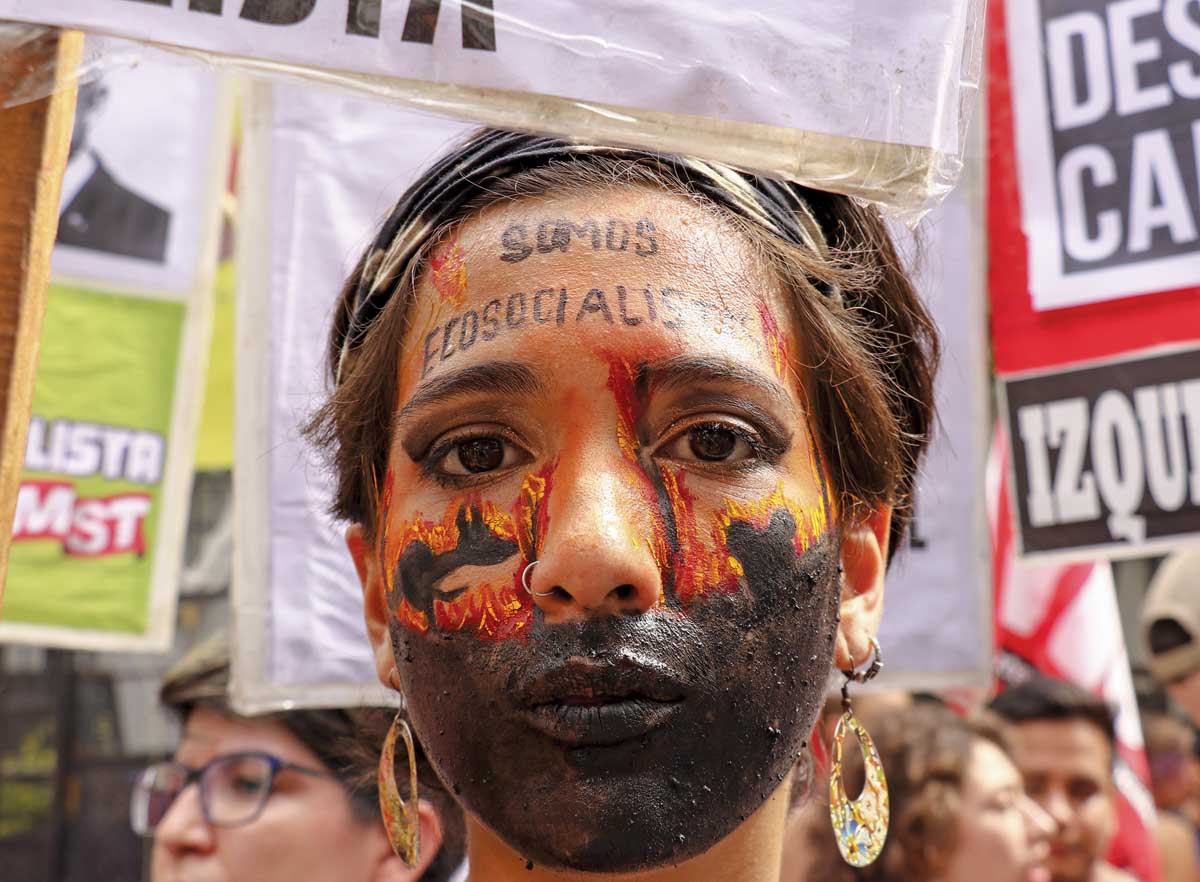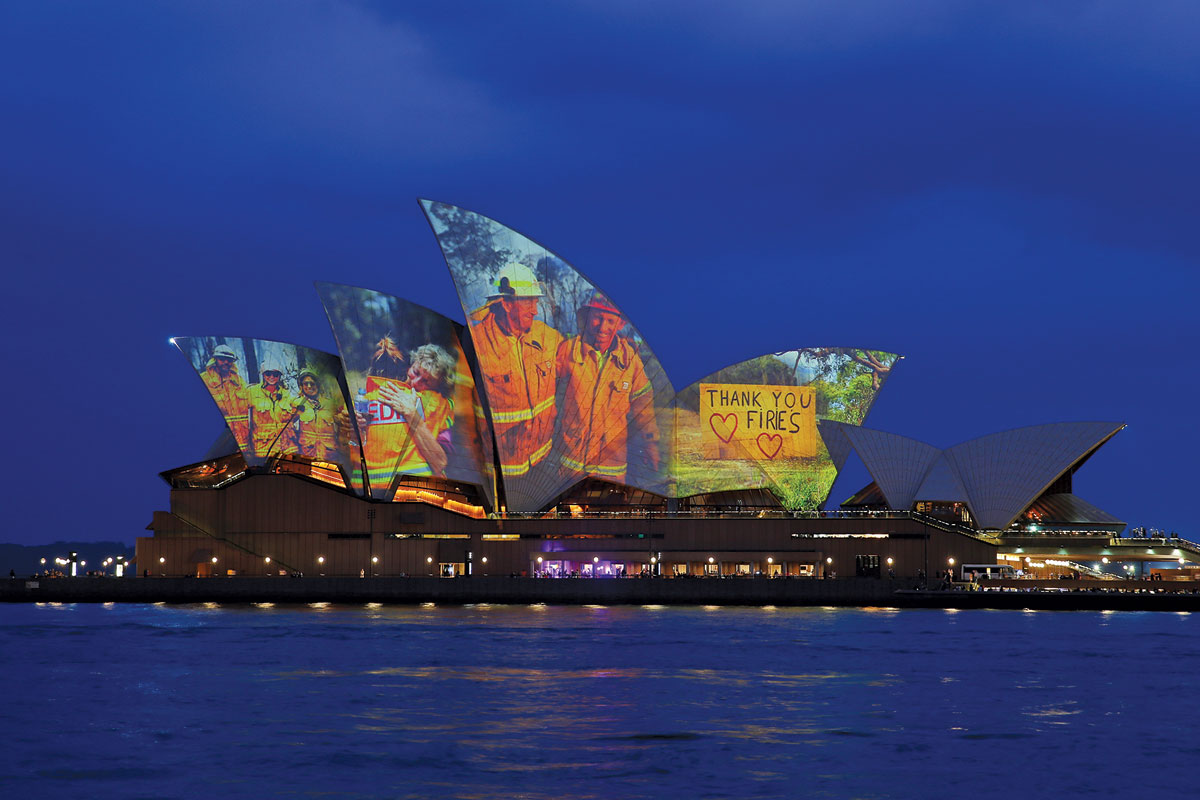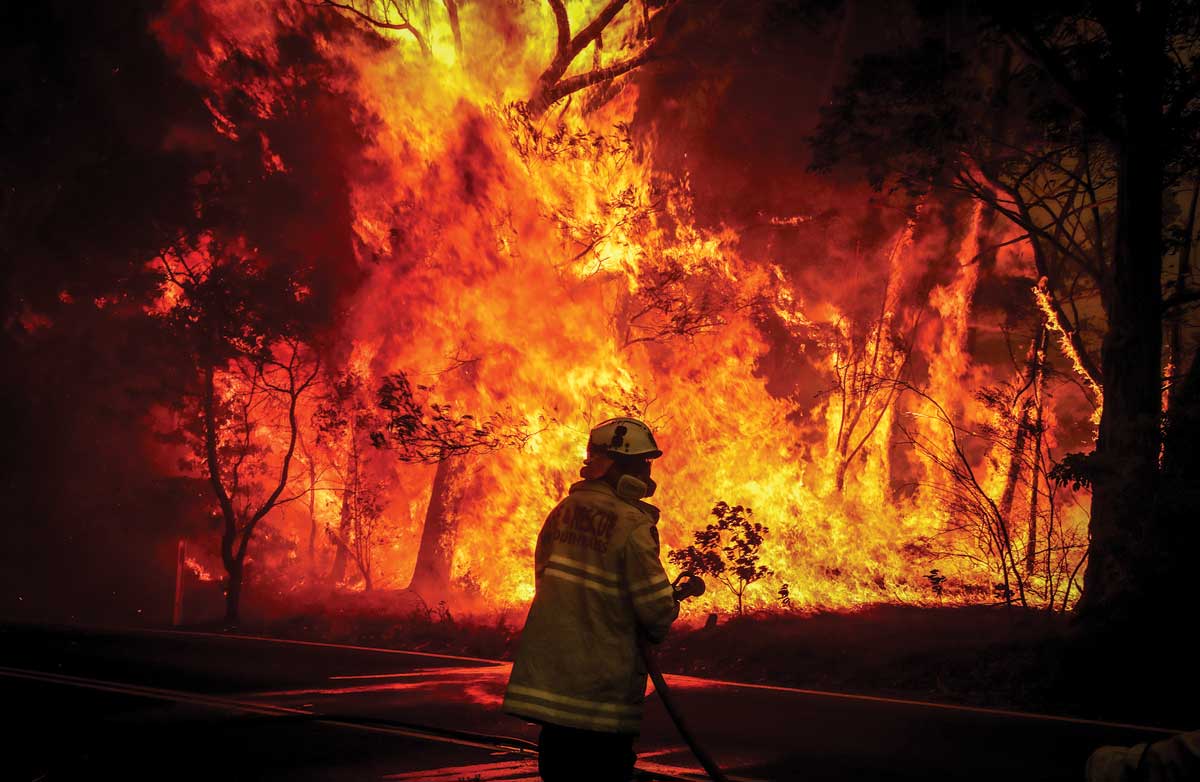Blue Mountains, Australia—“There is no one in this current federal government that has any semblance of a sense of crisis,” Mark Greenhill tells me as we sit in his mayoral office in Katoomba, a small town some 100 kilometers west of Sydney. It is December 19. For over a month, three massive bushfires have plagued this small mountain community, a UNESCO World Heritage site, ravaging its ecosystem and laying waste to residents’ homes. I could smell the smoke in Sydney that morning; the haze descended on the city at least a dozen times in the past month, casting a sepia-toned pall and tripping office fire alarms. But it was nothing compared with Katoomba, where my eyes began to burn the moment I stepped off the train.
As Greenhill speaks, his eyes dart to the window behind me. “Oh, fuck,” he says. I turn to look. A thick gray plume is billowing up from the trees just north of us. He jumps up and rushes to the window. “That is a cloud of fire,” he says. “That’s climate change right there.” A moment passes as the two of us stand in silence. “So, so,” he continues, picking up his train of thought, “there’s no sense of that national crisis. And that’s what we’re missing.” He points back to the fire cloud—“I’m just going to find out what that is”—and begins texting furiously.
The technical term for what we saw that day is “pyrocumulonimbus,” or “pyroCb” for short. PyroCbs are weather events generated by wildfires. They can produce dry lightning storms, high winds, even full-blown tornadoes. (An aerial photo of the Hiroshima bombing, long thought to capture the distinctive nuclear mushroom cloud, was only recently reidentified as an image of the pyroCb from the ensuing firestorm that swept through the city.) In recent weeks, “pyroCb” has become a household term in Australia—a literal manifestation of the fires but also a symbol, nudging us to see what is happening to the country in the terms of armed conflict. As the fires tear through town after town with ruthless efficiency, pyroCbs lend them the look of an airborne attack: climate blitzkrieg. When Prime Minister Scott Morrison called in the navy to evacuate thousands of people stranded on beaches and mobilized the Australian Defence Force to help fight the fires, the symbolism became reality. Australia went to war with itself.
An uncanny effect of the climate crisis: The way we describe the world no longer lines up with the way the world is. “A smoke-free zone,” reads a sign on Katoomba’s main street. Similar notices are posted throughout downtown Sydney. The fires have made them ironic. Meanwhile, a host of common metaphors—“can’t handle the heat,” “playing with fire”—have become uselessly literal (much in the way that “trump” is now a tainted verb). And then there are moments when reality has turned so surreal that our depictions of it become the ghostly receipts of normality. In Katoomba, tourists have begun taking selfies in front of posters of its famed mountain vista; the real view is hidden behind a screen of smoke. Such dissonances seem trivial when compared with the destruction wrought by the fires. But I found them profoundly disturbing to witness. They are signs that the link between the world and our words is beginning to fray.
Popular
"swipe left below to view more authors"Swipe →Perhaps the most brutal irony of all has been the Australian government’s response to the crisis. Much attention has been paid to the Morrison government’s complacency—the inadequate provision of aid, a prime minister who opted for a secretive holiday in Hawaii while public servants and volunteers begged for government help. But one of the unintended effects of this inaction has been to distract from what the government was doing during the crisis. While the bushfires raged in Australia, the country’s delegates to the United Nations’ climate negotiations in Madrid helped undermine international climate policy by insisting, through obvious accounting tricks that amounted to lies, that “Australia is also taking real action on climate change and we’re getting results,” as Morrison put it. But which results exactly did the prime minister have in mind? The catastrophic fires? The unlivable cities? The deaths of his citizens?
Once climate change becomes a crisis in wealthy, white-majority, Western nations, then surely we will act. This has long been an unspoken tenet of climate politics, a terrible but surefire last resort, and it is a statement I heard all the time in Australia: These fires are so severe, so terrible, so impossible to ignore, that something will have to give. ”There’s no way that politicians cannot react,” Julie-Anne Richards, the executive director of Climate Action Network Australia, tells me by phone as I ride the train back from Katoomba to Sydney, queasy from the smoke. “There’s no way that people experience what we’re experiencing right now and forget that by the next election.” This is one way to understand the fires, as the beginning of the end of climate inaction, a darkly apt coda to the year the world woke up to the climate crisis.
And yet, here and whenever else I heard it, this view was less a conviction than a hope. And behind that hope, a fear that somewhere along the path from the country’s climate crisis to its climate politics, something was broken. Perhaps, the fear goes, the lesson from these fires will be that there is nothing inevitable about the link between a harsher, more-present climate crisis and better climate politics. Perhaps it is just the opposite: The deeper the crisis, the harder it becomes to act.
In terms of climate justice, Australia is a rare combination of perpetrator and victim. Its politics are steeped in denial, its politicians beholden to fossil fuel and mining interests. How catastrophes like these fires—clear, stinging evidence of the climate crisis that the country’s policies have helped cause—will impact those politics is one of the most important questions of the next decade.
Just before he spots the fire cloud, Greenhill spreads a map of the Blue Mountains on the table in front of us. The region includes Katoomba and a number of other mountain communities in (normally) lush green forests. “We’ve got winds pushing this fire south at the moment,” he tells me, gesturing to the northern part of the map, where the Gospers Mountain mega-fire has already burned over 1,000,000 acres. “So this hits us in the next few days, probably. Wind changes towards the back end of the next couple weeks,” he continues, sweeping his hand northward from the southeast, where two more fires are threatening to combine. “So we face the prospect of being hit from this side and being hit from this side”—north and south. “That’s never happened before.”
Australia has seen many terrible fire seasons. In 2003, fires swept through the suburbs of Canberra, the nation’s capital, killing four people and destroying hundreds of homes. In 2009, bushfires in the state of Victoria killed 173 people in a single day—the worst bushfire disaster in Australian history, now referred to simply as Black Saturday. But every climate scientist and firefighter I spoke with confirmed Greenhill’s claim: It has never been like this.
The conditions are unprecedented. Back-to-back droughts have turned even rain forests into kindling. With the droughts has come heat. Last year was the hottest on record in Australia. December 17 was the hottest day in the country’s history, with a national maximum average of 105.6 degrees Fahrenheit. As I write on the afternoon of January 4, it is 120 degrees in the town of Penrith, at the base of the Blue Mountains, which makes it the hottest place not just in Australia but in the world. And with the heat come winds—“dessicatingly dry,” in the words of one expert—that whip up fires and smuggle embers across the containment lines.
The scope of the fires is unprecedented. New South Wales, the state that has borne the brunt of them thus far, has seen several 100,000-acre mega-blazes with 200-foot flames and their own unpredictable weather systems, including a fire tornado (exactly what it sounds like) that flipped a 10-ton fire truck in the southeastern town of Jingellic in December, killing a firefighter. Greg Mullins, a former fire commissioner of New South Wales, tells me that in his 48 years of firefighting, he had never seen conditions this severe. “I’m seeing things that I don’t understand,” he says. Other former chiefs from different states confirm this sentiment. Naomi Brown, a former head of the Australian Fire and Emergency Service Authorities Council, tells me this season “hit us like a train.”
The consequences of the fires are unprecedented as well, with more than 2,000 homes destroyed, at least 28 people dead, and over 26 million acres burned (compared with 1.9 million acres in California in 2018)—to say nothing of the noxious smoke, which has spread all the way to Chile and made Canberra the most polluted city in the world. Along the country’s southeastern coast, mass evacuations have been organized by the Australian Navy, with the help of Esso, an arm of ExxonMobil, which dispatched two of its ships from oil rigs to help the stranded. (The company was “ready to assist in whatever way possible,” according to The Age, though presumably that doesn’t include curbing its projected 35 percent increase in oil production from now to 2030.) And then there’s the carbon footprint of the fires themselves, 400 million tons of carbon dioxide at the time of writing, which is well over half the amount that Australia emitted in 2018.
To dispense with the obvious: “There’s no doubt that climate change is the culprit,” David Bowman, a fire expert at the University of Tasmania, tells me. Climate scientists have been predicting this kind of catastrophic fire season for years, he adds.
And we are nowhere near the end. Australia’s worst fires normally occur in late January and early February. (The 2003 Canberra fires erupted on January 18; Black Saturday was February 7, 2009.) “We’re in the fog of war!” Bowman exclaims when I ask him how bad the damage will be. The only thing that will stop the fires is sustained rain, he continues, and that may not come for months. “Look, mate,” he says, “if you’re looking at these weather forecasts and there were no fire right now, you’d be worried.” Toward the end of our conversation, he says, unprompted, “I just have this sickening, sinking feeling.” And then, three times, almost to himself, “There’s just too much fire in the landscape.”
While we’re waiting for news about the fire cloud, Greenhill drives me to one of Katoomba’s lookout points in the “mayoral limo” (his Kia Rio). As he winds up the deserted mountain roads—the Rural Fire Service has closed most of them—I ask him for a quick stock take. Enough fire volunteers? He laughs. “No. Nowhere near. A portion of our trucks are actually in other parts of the state fighting fires, so we’re really stretched,” he says. Water levels? “Shit! About 30 percent.”
As we pull into the lookout, I can barely refrain from gasping. Smoke spreads across the valleys that surround us. The land—full of vibrant green in the pictures I’d googled hours before—is a uniform orange-brown, so irrevocably parched that it is hard to see how it ever had been or could be otherwise. “Worst-case scenario is that we get smashed on all three sides,” he says. “Homes and lives.” He doesn’t even have to say “lost.”
As we retreat from the lookout, I ask Greenhill, who moved to the Blue Mountains 30 years ago and has been mayor for the past six, what he would do in that worst-case scenario. “I’ll stay,” he says decisively. “I figure it’s my job to stay. If I go, what kind of signal does that send? But this is all about climate change,” he continues. “Bushfires happen all the time in the Blue Mountains, but not like this. Not with the bush as dry as it is, not with so many fires, not with rain that hasn’t come and won’t come, you know, fire behavior that I’ve never seen before…. That’s why it’s part of the climate crisis. It’s the sheer number and scale of the fires and what sits behind those fires that is truly worrying.” Later, back in his office, he tells me, “I guess there’s a sense of dread right now. You’ve seen the maps. The city that I lead and have led for years now is literally surrounded by fire.”
On the day I visited Greenhill, Scott Morrison was in Hawaii on his ill-timed vacation. (His office initially insisted that reports of the trip were “wrong” but sheepishly retracted that after pictures of the prime minister—or “Scomo,” as he is not so affectionately known to Australians—surfaced of him bro-ing it up with Aussie tourists on a beach.) Only when the deaths began to mount and apocalyptic images made the front page of newspapers around the world did Morrison begin a tour of the affected areas and announce a more robust federal response.
But better disaster relief does not imply better climate politics. In September, David Littleproud, the minister for water resources, drought, rural finance, natural disaster, and emergency management, proclaimed, “I don’t know if climate change is man-made.” In November, Michael McCormack, the deputy prime minister, went on the radio and, stringing together a haphazard collection of right-wing buzzwords, denounced the “pure, enlightened, and woke capital city greenies” and “inner-city raving lunatics” who were trying to link the bushfires to climate change.
Both later reversed their positions. But that only paved the way for a second wave of denial: the notion that climate change is man-made but it isn’t Australians who are causing it. This has become one of Morrison’s main talking points. “The suggestion [in] any way, shape, or form that Australia, accountable for 1.3 percent of the world’s emissions, that the individual actions of Australia are impacting directly on specific fire events, whether it’s here or anywhere else in the world, that doesn’t bear up to credible scientific evidence,” he said in November. After repeated questions from journalists at a press conference on January 2, he conceded that climate change had worsened the fire season. But he has yet to back away from the not-Australia’s-emissions line.
Morrison is relying on the fact that the way we think about responsibility for climate change has lagged the way climate change actually works. Of course Australia’s emissions are not directly or solely responsible for its fires. (Would that climate change were so just!) But the country is the 15th-largest emitter of greenhouse gases in the world, and its emissions per capita are the highest among members of the Organization for Economic Cooperation and Development—more than three times the global average. Also, Australia is the world’s largest exporter of coal and liquefied natural gas. Until we move beyond understanding responsibility for the climate crisis as a direct correlation between one particular set of emissions and one particular natural disaster, politicians like Morrison will keep getting away with their bad-faith claims.
As the fires worsen into Australia’s gravest national crisis since World War II, Morrison is leaning hard on another defense. He concedes that climate change is real, that it is costing Australia lives and land, and that reducing emissions will contribute to mitigating the crisis. But he insists that Australia has already taken the robust climate action his critics demand. “The business-as-usual model gets us there in a canter,” he said of Australia’s emissions reduction pledge under the Paris Agreement. “Our climate policy settings are to meet and beat the emissions reduction targets,” he asserted in a recent press conference.
This is a different strain of denial: not a dismissal of the science or an obfuscation of responsibility but rather a complete reshaping of the past. It is the culmination of a decades-long effort by Morrison’s predecessors to put in place the kinds of deceptive structures—accounting tricks, low expectations, complex legal loopholes—that would allow future governments to describe the history of Australia’s inaction on climate change as precisely the opposite.
That effort began in 1997 with the first landmark climate agreement, the Kyoto Protocol. Under Kyoto, Australia was one of the only developed nations that negotiated a commitment to increase its emissions, by no more than 8 percent over 1990 levels by 2012. Even at that time, this was an absurdly low bar to clear. (The US agreed to cut its emissions by 7 percent.) And yet the government wanted more. In the final hours of the negotiation, the Australian delegation demanded—on pain of scuttling the entire protocol—that changes in land use count toward emissions calculations. The rule has come to be known as the Australia clause.
Why land use? “There was a huge amount of land clearing that had happened in the years before 1990,” explains Mark Howden, a professor at the Australian National University and a lead author on reports of the UN’s Intergovernmental Panel on Climate Change. More land clearing means more emissions from land use, but this is only temporary. Once the clearing is done, land use emissions steadily decrease over time. In other words, including land use emissions allowed Australia to measure its reductions from an artificially inflated starting point. The country could ramp up its fossil fuel use and rely on the expected decline in land use emissions to make the numbers look good.
That is precisely what happened. When land use figures are included, Australia emitted just 2.5 percent more in 2012 than it did in 1990—far less than its deceptive Kyoto goal. When land use figures are excluded, however, it emitted 28.3 percent more. And that figure does not include emissions from exported fossil fuels, a convention that greatly benefits Australia. The country’s emissions will likely continue to rise in the years to come, since the Morrison government does not have a plan to invest in renewables beyond 2020, and the lone piece of federal climate legislation on the books, the Climate Solutions Fund, is set to receive a total of AU$2 billion over the next decade—about as much money as Amtrak receives in a single year from the US government. (In other words, not much.) To tout these figures as an accomplishment is an astonishing act of bad faith.
At the recent UN climate negotiations in Madrid, Australia went further still. In the 2015 Paris Agreement, it pledged to cut its emissions 26 to 28 percent compared with 2005 levels by 2030, which, according to the Climate Analytics, a nonprofit climate science and policy group, would translate to a mere 5 percent reduction from 1990 levels (excluding land use). But in Madrid, the Australian delegation insisted that the overshooting of its Kyoto pledge be counted toward the calculation of its reductions under the Paris Agreement. That way, Australia would need to cut its emissions by only 16 percent from 2005 levels to meet its Paris goal; the rest would come from its Kyoto credits. (Yet even if the Paris target is met in earnest, it will be wholly insufficient, since it is consistent with a rise in average global temperature of 2 to 3 degrees Celsius from preindustrial levels—well above the already dangerous goal of 1.5 degrees.)
This strategy, known as carrying over carbon credits from one treaty to another, is like accruing rollover minutes on one phone plan and then trying to use them with a different carrier. In Madrid, dozens of countries pleaded with Australia not to pursue its carryover policy, but Australia refused to budge. The ensuing anger was fierce. Laurence Tubiana, a former French environment minister and a key figure in the Paris negotiations, told the Financial Times after the Madrid conference that the carryover “is just cheating… Australia was willing in a way to destroy the whole system, because that is the way to destroy the whole Paris agreement.”
So, a country that negotiated a commitment two decades ago to vastly increase its carbon emissions and then proceeded to greatly increase them now wants to use that difference—from vast to great—to reduce its current reductions pledge, which it is not on track to meet, even with this creative accounting scheme. Small wonder that the 2020 Climate Change Performance Index ranked Australia last out of 61 high-emitting countries for its climate policies. On a scale of 100 possible points, the index awarded the Lucky Country a score of zero.
The Morrison government’s response to the bushfires has prompted comparisons to the conservatives’ response to mass shootings in the United States: insisting that now is not the time to “politicize” the issue, shrouding inaction beneath a veil of mourning, talking about tangential problems, and waiting it out. While the analogy is disturbingly apt, it doesn’t go far enough because it doesn’t capture the government’s attempt to retroactively write climate action into Australia’s past. Morrison is no longer saying that the country doesn’t need to act on climate change. He is saying something far more sinister, that we have already acted. (And by “we,” he means his own Liberal Party. On December 22, The Guardian reported that his government adjusted the way emissions are measured so that, projected backward, emissions during the previous three Labor governments increased, while emissions under the Liberal coalition declined.)
So far, there have been very few cracks in this Liberal front. In mid-December, the Liberal minister for environment in New South Wales, Matt Kean, broke ranks with his party to insist that the fires were linked to climate change and that “doing nothing is not a solution.” For this remarkably mild admission, he was reprimanded by Australia’s army of Rupert Murdoch–owned newspapers and by his own party. “We stand by everything we’ve said,” a skittish press secretary in Kean’s office assured me when I called to request an interview. “But as you can understand, we’ve had quite a week here.” (He ultimately declined to be interviewed and has since gone silent on climate.)
None of this was inevitable. Only a decade ago, Australia was actually poised to lead on climate politics. In 2006, according to a poll conducted by the Lowy Institute, an Australian think tank, 68 percent of Australians agreed with the statement “Global warming is a serious and pressing problem” and “we should begin taking steps now even if this involves significant costs.” Politicians listened. In the 2007 election the Labor Party candidate, Kevin Rudd, campaigned on the promise of an emissions-trading scheme. So did John Howard, the Liberal incumbent who, a decade earlier, oversaw Australia’s deceptive accounting at Kyoto. When Rudd won the election, he set about negotiating an emissions-trading scheme with the Liberal opposition, led by Malcolm Turnbull. It looked as though there would be a genuine consensus on aggressive (if wholly market-driven) climate action.
Instead, negotiations over the trading scheme fell apart. Then the Green Party sided with the Liberals in voting against the final bill, claiming it was an insufficient response to climate change. (Labor has never forgiven the Greens for this; Greenhill, a Labor Party member, called the vote a “political stunt.”) The Liberals became the party of climate denial, and public opinion shifted accordingly. By 2012, the Lowy poll showed 36 percent of Australians in favor of immediate, significant action on climate change—a more than 30 percentage point drop in just six years. (Since then, the figure has climbed steadily, reaching 61 percent in 2019, but it has yet to return to its 2006 benchmark.) Climate change became, as journalist Annabel Crabb wrote last year, “the most divisive issue of the Australian political century.”
Meanwhile, Labor has spent the last decade toggling between appeals to its working-class base in Queensland—coal country—and demands for a stronger climate policy. Last May the party suffered a surprise loss to Morrison’s Liberals in what was billed by some media outlets as a climate change election. Labor leaders maintain that the loss was not a refutation of their climate policies. “There were a few key factors about why we didn’t win the election,” Mark Butler, a Labor MP for Hindmarsh and the current shadow minister for climate change and energy, tells me. “Climate wasn’t one of them.” If the election had been “a referendum only about our climate policies,” he insists, “I think you may well have seen a different result.” But when I press him on this—Labor suffered key losses in Queensland, where the debate over whether to open the Adani coal mine was central to the election—Butler concedes that “even though our climate policy was not going to directly impact coal mines, there was this sort of sense that we didn’t support their jobs.”
When I ask the Climate Action Network’s Richards what has driven this regression in climate policy, she immediately replies, “Two words: coal lobby.” Coal looms over Australian politics and culture. Magnates like Gina Rinehart and Clive Palmer are easily recognized public figures. In the last election, Palmer poured AU$60 million into a smear campaign against Labor. They knew they’d have a friend in Morrison, who made his name in 2017 by presenting a lump of coal in Parliament, James Inhofe–style, and saying, “This is coal. Don’t be afraid.”
Dotted against this dim backdrop are a few ironic points of light. Many of the public servants closest to the fires—like Naomi Brown and Greg Mullins—have called the government on its lies. “I think the whole country is being gaslighted right now,” Brown tells me. In April she, Mullins, and 21 other former emergency service leaders founded the Emergency Leaders for Climate Action and wrote to the federal government warning of “increasingly catastrophic extreme weather events.” They asked for bolstered emergency services and rapid climate action. Morrison refused to meet with them.
I met Brown and Mullins at a press conference in the Sydney Botanical Gardens. Standing in front of a fire truck, accompanied by four other former fire chiefs, they called the press conference to announce the formation of the emergency council on bushfires—with or without the prime minister. Mullins, the group’s unofficial leader, told me gruffly, “I will not stand by as some politicians in denial ruin the world and this country.” The event was a powerful image: six retired emergency leaders, their faces leathered from decades of firefighting and looking uncomfortable in their business suits, throwing their clout behind climate action.
There are protests, too. In Sydney the week before Christmas, I saw a gathering almost every day, from Extinction Rebellion die-ins to marches thousands strong across the Sydney Harbour Bridge to Morrison’s residence. I attended one a few days after visiting Katoomba. The protesters, most of them under 25, kept up a rousing “Scomo, fuck you!” all the way to the prime minister’s doorstep. It was not a joyful gathering. You could see, hear, and feel the anger.
But it was despondent anger, anger that came from the belief that no change in government would be enough at this point. “Not Labor, they’re shit too!” someone shouted during a speech, prompting laughter and applause. Richards, who attended a march a few days earlier, told me she sensed the same thing. “The mood felt flat,” she said. “People don’t know what to do. They don’t want to be resigned, but they’re fighting that feeling.”
It is not hard to see why. The fires are international news now, but how long can that last? Rain will come (eventually), and the press will move on. The next fire season might not be quite so bad; that is always the risk of relying too heavily on weather events to demonstrate climate change. And the government is cracking down on climate protests by threatening multiyear prison sentences for activists. “Perhaps this is going to be the moment when the climate crisis becomes real,” I say to Mayor Greenhill on our drive up to the lookout in Katoomba. “Yeah,” he responds with surprising bitterness and tugs the car roughly into a curve. “Then winter comes, and the bastards forget about it.”
There is a line from an essay that has stuck with me throughout my time in Australia, lodged in my mind like a song lyric. The essay is “Truth and Politics” by Hannah Arendt. Writing in 1967, she asked why it was that lying seemed so much more prevalent in politics than “truthtelling: to say what is.” Her answer was that politics is at its core about “changing reality,” breaking free from the world as it is and “beginning something entirely new.” According to this definition, truth is a constraint on our ability to alter the conditions around us. “Seen from the viewpoint of politics, truth has a despotic character,” she wrote. When a potential future turns into an actualized present, it acquires a “stubborn thereness” that places it beyond politics. It just is.
The political response to undesirable truths, Arendt feared, would be the lie—a weapon that extends our ability to change the world into an area that ought to remain beyond our agency. To lie “is clearly an attempt to change the record,” she wrote, “and as such, it is a form of action.” The liar “says what is not so because he wants things to be different from what they are—that is, he wants to change the world.” Lying in politics, then, is action pointed in the wrong direction, not toward the future, which is up for grabs, but toward the present and the past.
That is the fear behind the hope in Australia. Far from providing more of an impetus for political action, the reality of the climate crisis may serve to make real action all the more inconceivable. In its place comes a perverse kind of climate action, a reaction: the Morrison government’s attempt to wrench Australia’s emissions record away from the factual and back into the political. “The past and the present are treated as parts of the future—that is, changed back into their former state of potentiality,” Arendt warned. So with climate politics in Australia.
Climate scientists warn of tipping points—thresholds that, once breached, could lead to irreversible changes in the global climate system. Tipping points are difficult to predict, although we now seem to be approaching some large-scale ones at a terrifying pace. But there are tipping points in climate politics, too, and we have arrived at one this summer in Australia. Which one, though? Will the fires send us mercifully toward the dramatic climate action that we now have only a decade to take? Or will they mark the moment when the climate crisis became too advanced to be altered and climate action became about cooking our books as our planet staggered toward untold dystopias? In the heat of the moment, it is hard to tell. But at the least it feels possible now to say that we are headed in one direction or the other—on the verge of a climate revolution or on the brink of a climate reaction.
Meanwhile, we are left with that strange dissonance, the world around us mocking the language we have built to name it. The line that has remained stuck in my head is the final sentence of “Truth and Politics”: “Conceptually, we may call truth what we cannot change,” wrote Arendt. “Metaphorically, it is the ground on which we stand and the sky that stretches above us.” Another metaphor that has now become real in Australia, where—in both senses—the ground is burning and the sky is full of smoke.

